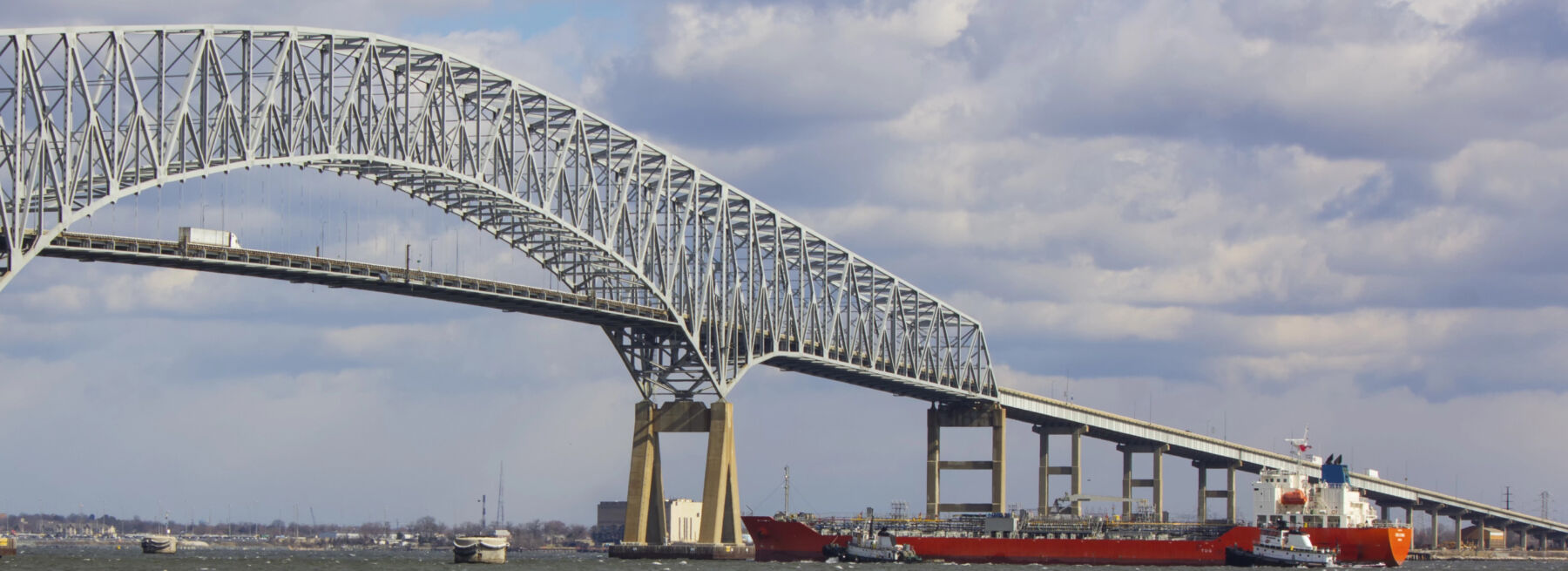It was the bridge collapse heard around the U.S. The cargo ship Dali lost power twice and crashed into Baltimore’s Francis Scott Key Bridge pillar. It caused the bridge deck to collapse. In the aftermath of the shocking collapse of the Key Bridge, the reverberations go far beyond the physical infrastructure. For affected businesses and industries, the event signals a time requiring swift assessment and strategic recalibration.
The collapse of a critical part of infrastructure more than disrupts daily commutes and logistics. It sent shockwaves through the economic ecosystem. The immediate repercussions of these jolts include everything from supply chain disruptions to changed consumer behaviors. In the face of uncertainty, once again business leaders arrive at an unexpected crossroads. They’re tasked with navigating the consequences while safeguarding their operations and stakeholders.
The 1.6-mile bridge facilitated more than 30,000 people’s daily commute. According to CNN, the bridge is the ninth-largest U.S. port for international cargo. In 2023, a record 52.3 million tons, valued at $80 billion, came through the port. It also supported more than 15,000 jobs and more than 130,000 related services.
Beyond the immediate challenges of rerouting shipments, the collapse spotlights vulnerabilities in the infrastructure networks. It serves as a reminder to prioritize investments in maintenance, upgrades, and resilience measures to help prevent future catastrophes. As businesses grapple with the fallout, they are also called upon to advocate for systemic changes and collaborative efforts to proactively address infrastructure weaknesses.
There is an upside amid the chaos, as it brings about an opportunity for change and innovation. The Key Bridge collapse compels businesses to reevaluate their risk management strategies, fortify their contingency plans, and adopt greater agility in responding to unforeseen events that no one ever thought would happen.
Additionally, it drives industries to build stronger partnerships with governmental bodies, community stakeholders, and fellow businesses to advocate for sustainable infrastructure development and disaster preparedness.
What are the multifaceted implications of the Baltimore Bridge collapse for businesses and industries? What are the immediate challenges, the long-term ramifications, and the actionable steps forward? Read on.
How the Bridge Collapse Impacted Construction?
The Baltimore bridge was the largest U.S. port by volume for construction machinery. Interact Analysis indicates the port of Baltimore ranked No. 1 in 2023 for imports and exports of farm machinery at $5 billion worth. It ranked No. 3 for construction machinery valued at $6.6 million. It will have a temporary impact on construction equipment supply and prices. Here are the short-term effects of the Interact Analysis report:
- Longer delivery times for construction machinery from outside the U.S. for items where Baltimore is the main entry point.
- For specific equipment types and models with no alternatives, companies using the equipment may experience a delay or higher costs. The impact depends on the equipment type.
- Specific vehicle models will most likely face a price increase and any changes to the logistics network will also add costs.
It’s possible that some models and specific dealers may experience delays, or the machinery may end up in a different location than originally planned.
Equipment World says that CNH Industry’s construction and agricultural equipment has a roll-on and roll-off average of between 14,000 to 16,000 units every year at the Baltimore port. Heavy equipment consists of compactors, wheel loaders, backhoes, and excavators. Many of these have been rerouted to other ports.
Experts believe there will be enough volume within inventory or from production to meet demand. However, some dealers may not be able to get stock and they can drive up prices. Interact Analysis believes the equipment challenges will be temporary as estimates to repair the bridge predict it will be open for business by late June.
Additionally, the port of Savannah in Georgia is No. 1 in 2023 for imports and construction equipment. Therefore, it’s expected the Georgia port will be able to manage the additional traffic.
What Does the Bridge Collapse Mean for Dealerships and the Automotive Industry?
The automotive industry was massively impacted as the Baltimore port was the busiest one for car shipments. The Maryland Port Administration says that more than 840,000 vehicles came through the Key Bridge in 2023 as confirmed by Automotive News. The brands included Audi, Bentley, General Motors, Jaguar Land Rover, Lamborghini, Mercedes-Benz, Mitsubishi, Nissan, Subaru, Stellantis, Toyota, Volkswagen, and Volvo. As a result, these automakers will likely see serious supply chain issues.
The Automotive story affirms there will be some disruption for the automotive industry. People quoted in the story believe there will be trucking delays due to the rerouting of traffic. Ford Motor Co.’s CFO says the company will divert parts to other ports. In doing so, the supply chain will experience delays.
A representative from Mercedes-Benz issued a statement that says they’re monitoring the situation and working with their logistics service and transportation providers to adapt and find alternatives. BMW says it only expects short-term traffic delays.
No doubt, the supply chain breakdown during the pandemic led to many lessons learned and changes for businesses. They’ve changed their supply chain processes to be more flexible. This allowed them to be better prepared for events like the Baltimore bridge collapse.
This flexibility comes at a price. The Detroit Free Press verifies that rerouting vehicle exports to other ports will be expensive for carmakers. They’re also looking for ways to offset delays in factories receiving needed parts.
“It’s a key port,” Sam Fiorani, vice president of global vehicle forecasting at AutoForecast Solutions of Chester Springs, Pennsylvania, tells Detroit Free Press. “It’s a big area and well-positioned because it’s so far inland so it catches the train lines and interstates up and down the nation. Everyone is retrenching at the moment to figure out what they’re doing” now that that waterway is closed down.
Will the Bridge Collapse Affect Vehicle Thefts?
Before the bridge collapse, Baltimore had a history of crime in which organized thieves would steal and transport vehicles overseas. In fact, federal and local authorities seized 13 vehicles at the Port of Baltimore last fall per a WTOP News Story. These had an estimated value of more than $400,000 and were heading to Western Africa. One piece of farming equipment stolen in Michigan almost made its way to South America.
The problem was so prevalent that the U.S. Customs and Border Protection had an operation for recovering stolen vehicles at the port before they disappeared as they were exported out of the country. Law authorities from multiple U.S. ports collaborated to recover more than 200 stolen cars with a value of more than $11 million. These, too, were designated for Western Africa.
A Way to Protect Automotive Makers, Dealerships, Ports, and Construction Businesses
Fortunately, there’s a proactive security technology that can help deter crimes and ensure businesses hold on to their expensive and irreplaceable assets. Video surveillance with remote monitoring that combines trained human monitoring operators with artificial intelligence has the power and flexibility to keep up with criminals’ latest tactics.
Security cameras can be installed across a dealership, port, and construction site including areas that are hard to see or for humans to navigate. Every square inch of the business can have eyes on it. The AI can automate the process of monitoring the cameras for suspicious activity. As soon as it detects a possible problem, it can notify the human monitoring operator.
The operator can investigate and act appropriately for the situation. They may issue a warning over an onsite speaker. The monitoring operator isn’t on the dealership or construction site. They work elsewhere and communicate remotely. If the onsite intruders don’t hear or heed the warning, then the operator can follow their movements while contacting law enforcement.
As law enforcement officers make their way, the monitoring operator can keep them informed of what’s happening at the scene. The officers can arrive armed with information from the operator that can help them stay safe and successfully arrest any suspects on the property.
At a time when unpredictable supply chain events happen, businesses can be better prepared by adopting innovative technologies like proactive video surveillance that effectively incorporates a human element to do the monitoring and responding. Of course, this security technology needs to be part of a holistic security framework as it’s important to support it with other security layers like lighting, access control systems, fencing, processes, procedures, and training.
Organized crime rings and other sophisticated criminals have the uncanny ability to adapt to the unexpected. Therefore, the automotive and construction industries must approach their security with the expectation something will happen. Video surveillance and monitoring along with an inclusive security strategy can help them keep up with the criminals. By doing so, they can help fortify and protect their businesses, assets, and equipment.
To find the right security partner, use this video surveillance checklist or pick up one of these guides.
- Your complete guide to securing your auto dealership
- 9 simple steps to secure your dealership lot
- Construction site safety and security solutions that work
Want to learn more? Contact us.
Texas Private Security License Number: B14187
California Alarm Operator License Number: ACO7876
Florida Alarm System Contractor I License Number: EF20001598
Tennessee Alarm Contracting Company License Number: 2294
Virginia Private Security Services Business License Number: 11-19499
Alabama Electronic Security License # 002116
Canada TSBC License: LEL0200704

